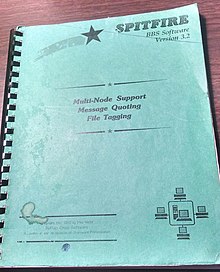This article has multiple issues. Please help improve it or discuss these issues on the talk page. (Learn how and when to remove these messages)
|

SPITFIRE is a DOS-based bulletin board system written by Mike Woltz (1945-2022), published by his company Buffalo Creek Software of West Des Moines, Iowa.
History
SPITFIRE was written in Turbo Pascal with assembly language routines. It was released in 1987 as shareware, and had a moderate sized fanbase, only outnumbered by products such as RemoteAccess, TriBBS, PCBoard, Major BBS, and Wildcat! BBS. It was possible to run multiple "nodes" of SPITFIRE under Microsoft Windows and OS/2; although, most SysOps preferred to use Quarterdeck's DESQview for this purpose. SPITFIRE interfaced with message relaying systems such as FidoNet through third party utilities such as SHILOH, a QWK networking interfacing program, and BCSUTI, a Postlink-style networking interface.
SPITFIRE's most successful release (Version 3.2) came in 1992. By December 1992, there were 1523 registered copies of Spitfire still running, out of 2111 total registered to date. But by 1994, the World Wide Web had exploded on scene, and many SysOps began converting from running BBSes to becoming Internet service providers.
Due to advances in technology, SPITFIRE can be run as a telnet BBS using a virtual FOSSIL driver and Telnet engine (SIO/VMODEM under OS/2, NetFoss, NetSerial or NetModem under Windows).
SPITFIRE (version 3.6) was updated in 1999 for Y2K compliance, and its most recent release is SPITFIRE 3.7 (Released in January 2010)
References
- "Michael David Woltz Obituary".
- Shipley, Jacque (January 1993). "Keeping in Touch". Spitfire Monthly Support Newsletter. SF01-93 (January 1993). Retrieved 16 September 2021.
External links
"Buffalo Creek Software". Buffalo Creek Software. Archived from the original on 4 December 2022. Retrieved 24 April 2023.
Categories: